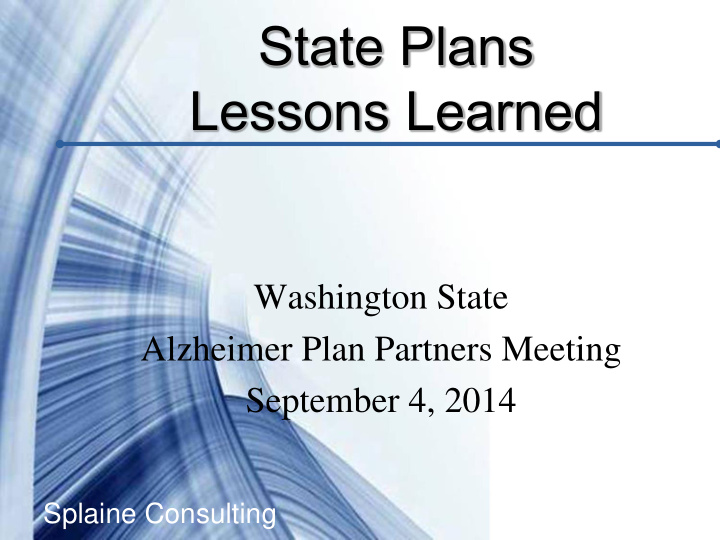



State Plans Lessons Learned Washington State Alzheimer Plan Partners Meeting September 4, 2014 Splaine Consulting
Disclosures Consulting Agreements as of 9/1/2014 Alzheimer’s Disease International Consumer Voice (aka NCCNHR) Eli Lilly Bayer A.G. (non-U.S.) Alzheimer’s Association (US) Healthy Brain Initiative Elder Justice ACTion, Elder Justice ACTion SC Alzheimer’s Association GA/GA Dept Aging Also: Splaine is CEO and principal member, Cognitive Solutions LLC
Conflict of Interest • None of the views represented here are those of my clients nor have they had any control or input into this presentation.
Overview • Why plans? • Highlights from implementation • Follow the evidence: caregiver support in Alzheimer plans • Questions and answers
Recognition, terms • Special thanks to ADI for the use of their global data slides. • The term Alzheimer’s disease is intended to be inclusive of related irreversible dementias in and Alzheimer’s detected at the time of cognitive symptoms are present.
Dementia worldwide
2007 Goals for state plans • NOT Ageing, but health and public health • Evergreen • To the limit of the evidence available • Inclusion of persons with the disease • Not necessarily new spending, better spending
A Comprehensive Approach to Alzheimer’s: It’s a life course disease. Public c Health ADNI: Alzheimer’s Disease Neuroima imagin ging g Initiat iative ive ADSSP: Alzheimer’s Disease Evide dence nce-Ba Based sed Practice tice Supportive rtive Services ices Progra ram Recomme mend ndatio ations ns Numbe ber of People e Affec ected ed
What makes ADRD Different? • Families are the caregivers. • Gap between prevalence and diagnosis • Diagnosis late in disease process • Co-morbid chronic diseases Lack of attention to population health/risk Siloed budgets and systems • Stigma, nihilism, ageism plus capacity • Duration of disease process, care • Special pops: complicated lives
Evidence: Impact on family caregivers • Higher levels depressive symptoms • Perceived burden increase as function declines • High levels of stress and frustration • Exhaustion, sleep problems • Women fare worse in all of these elements • Some evidence linking stress and abuse • Social/economic development impact
Impact part 2 • About 1/10 report “harmed their health” • Lower levels subjective well being and health • Higher rates of dementia • Increased risk heart disease, poor wound healing • Physical strain of caregiving • Lower levels of self care and preventive health behaviors
Relationship to national plan • See Baumgart’s Venn diagrams • Dually eligible persons • Quality care issues • Solutions for financing ltss
Some process learnings • Early stage persons • Policy document • It’s not always spending money. (Vaud, Suisse) • It might be about economics. (FR) • Priority setting with transparency
What Alzheimer’s do we plan for?
Tactical Options from plan implementation (18) • Excellent accurate public health sourced information • Access to diagnosis • Anti stigma campaigning (Scotland, UK) • Telemedicine and telephone based support • Alzheimer friendly communities (Belgium) • Promotion of programs to meet unique needs (FR) • Pathway of post diagnostic support • Translating evidence based programs into mainstream and achieving scale
Contact information • www.splaineconsulting.com • www.cognitivesol.com • mikesplaine@verizon.net
Recommend
More recommend